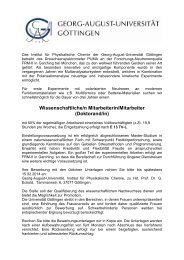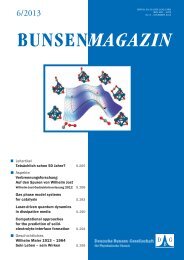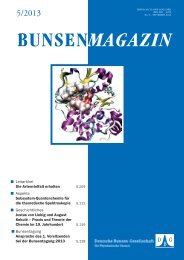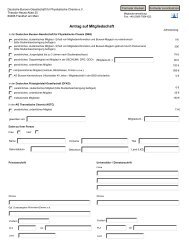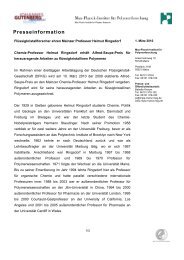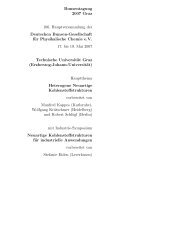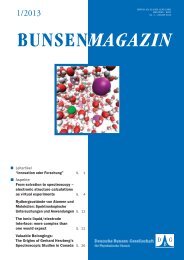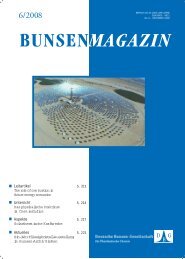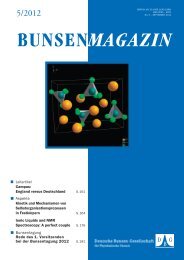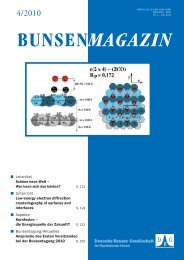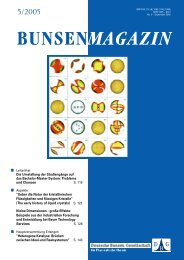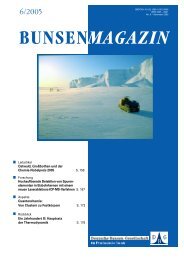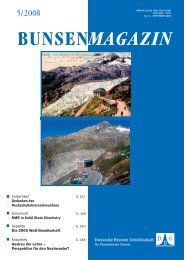BUNSENMAGAZIN - Deutsche Bunsengesellschaft für ...
BUNSENMAGAZIN - Deutsche Bunsengesellschaft für ...
BUNSENMAGAZIN - Deutsche Bunsengesellschaft für ...
Sie wollen auch ein ePaper? Erhöhen Sie die Reichweite Ihrer Titel.
YUMPU macht aus Druck-PDFs automatisch weboptimierte ePaper, die Google liebt.
DEUTSCHE BUNSEN-GESELLSCHAFT<br />
Figure 5: Schematic 2D-DQ-spectrum of a two-spin system with spin A (w A )<br />
and spin B (w B ), recorded in rotor-synchronized fashion. All correlation<br />
peaks in the DQ dimension appear at the sum frequency of the coupled<br />
spins, where we can distinguish auto-correlation peaks at the diagonal<br />
from cross-peaks that are off-diagonal. 13a<br />
In addition, we exploit the fact that observable DQ signal intensi-<br />
2 -6 ties are proportional to D or rij , respectively (Dij is the homo-<br />
ij<br />
nuclear dipolar coupling constant, r the internuclear distance).<br />
ij<br />
Strong signal intensities in the corresponding (rotor-synchronized)<br />
double-quantum spectrum therefore reveal protons in rather<br />
close spatial proximity (e.g., distances up to 3.5 Å). This can be<br />
used in a qualitative way to derive fi rst distance constrains of the<br />
coupled protons and thus provide a glimpse on possible arrangements.<br />
Notably, DQ MAS NMR is based on analyzing signals<br />
resulting from a coherence originating from two spatially separated<br />
nuclei. Thus, the basic physics is analogous to coherent<br />
X-ray or neutron scattering, where the coherent superposition<br />
of scattered waves is exploited to deduce the distance between<br />
the scattering centers. In NMR, however, no translational symmetry<br />
is necessary to determine distances in the range of 100<br />
to 1000 pm. 31 More accurate values for dipole-dipole couplings<br />
may be obtained from so-called build-up curves of DQCs, which<br />
for isolated spin pairs, such as doubly labeled 13C-13C, exhibit an<br />
oscil latory behavior. 32 Strongly coupled 1H-1H systems, however,<br />
quickly develop a multi-spin character and the oscillations are<br />
damped out. Nevertheless, even there the initial build-up is dominated<br />
by DQCs and can be analyzed quantitatively. 33,34<br />
Figure 6: Comparison of a rotor-synchronized 2D DQMAS spectrum and its rotor-encoded<br />
spinning sideband pattern. Note that the frequency distribution<br />
(and thus intensity distribution) can be pumped according to the product of the<br />
DQ excitation time (t exc ) and the respective homonuclear dipolar coupling D ij . 35<br />
UNTERRICHT<br />
For spin pairs, and even more so for dipolar coupled clusters<br />
(e.g. triple- or quadruple hydrogen-bonded moieties), the underlying<br />
dipolar couplings and hence the geometry of the spin<br />
system can be much better elucidated if DQ spinning sidebands<br />
are generated. This can be achieved by choosing t time 1<br />
20,30 increments well below t where the reconversion is rotor<br />
R<br />
encoded because the dipolar Hamiltonian that is modulated<br />
by MAS differs at the beginning of both the excitation and reconversion<br />
periods (cf. fi gure 7). This mechanism is termed<br />
Reconversion Rotor Encoding (RRE) and occurs, whenever the<br />
Hamiltonians involved have an amplitude modulation on the<br />
rotor phase. Notably, RRE produces odd-order spinning sidebands<br />
only. In actual applications, the rotor frequency w and R<br />
the excitation time t will be chosen such that up to third order<br />
exc<br />
sidebands are generated thereby achieving suffi cient signalto-noise<br />
ratios. In contrast, multi-spin effects (e.g. a spin pair<br />
is coupled to a third spin) give rise to additional (even order)<br />
sidebands and are therefore easily recognized. 35,36<br />
Figure 7: Schematic representation of the reconversion rotor encoding<br />
(RRE) in case of t 1 increments different from a rotor period t R . As indicated<br />
by the sinusoidal wave, an additional phase factor that depends on the rotor<br />
frequency is added to the reconversion Hamiltonian. 20<br />
Though two-dimensional 1 H DQ MAS experiments have found<br />
manifold application, such experiments still suffer from the<br />
rather limited spectral resolution in solid-state 1 H NMR even<br />
at currently available fastest MAS frequencies of up to 70 kHz<br />
and highest magnetic fi elds (≥ 20 T). Indeed, in favorable cases<br />
of structurally well-ordered (mainly crystalline) samples, where<br />
the experimentally observed 1 H MAS NMR line shapes are solely<br />
broadened by strong homonuclear dipolar couplings among<br />
abundant protons, remarkable resolution can in principle be<br />
obtained using so-called homonuclear dipolar decoupling sequences<br />
like windowed phase-modulated LEE-GOLDBURG<br />
(wPMLG) 37 or windowed DUMBO-1 38 that also constitute the<br />
key part of high-resolution DQ spectra (DQCRAMPS). 39 This approach,<br />
however, is often limited to model compounds 40 but has<br />
also been successfully applied to biologically relevant systems. 41<br />
Despite the fact that the technical implementation of such dipolar<br />
decoupling sequences on the actual NMR console varies<br />
substantially, the basic idea to align the magnetization along an<br />
effective radiofrequency fi eld at the magic angle with respect<br />
to the static magnetic fi eld is retained. In oversimplifi ed words,<br />
reduction (or even complete removal) of line-broadening due to<br />
65



